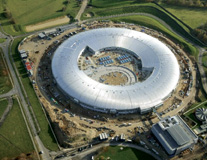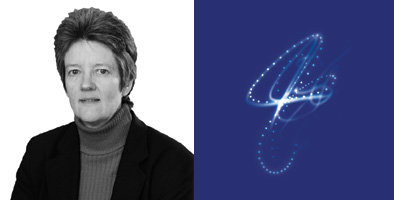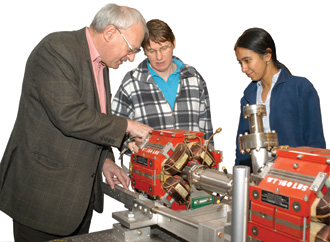Springtime at Daresbury
How a quiet, unassuming laboratory in the northwest of England transformed itself into a powerhouse of accelerator physics and technology.
by Judy Jackson
 The Bridgewater Canal, the first canal built in England, flows past Daresbury Laboratory, whose signature tower, once used for nuclear physics experiments, now houses R&D for a fourth-generation light source now under development at the laboratory. Photo: Daresbury Laboratory |
Daresbury Laboratory lies in the green and pleasant countryside of Cheshire, about a 40-minute drive west from Manchester, not far from the Welsh border. Lewis Carroll was born in Daresbury. The Bridgewater Canal, the first canal built in England, flows past the laboratory, and on a day in mid-February, the daffodils were blooming. So was the accelerator physics.
That was not always the case. Although Daresbury began life in 1962 as a high-energy physics laboratory, the 1972 decision of the UK government to pull back from building independent accelerators in Britain in favor of collaboration with Europe's CERN and DESY laboratories quashed the laboratory's plans to build a forefront superconducting proton machine. For years after that, Daresbury was a laboratory that knew its place. It was home to the world's first dedicated synchrotron light source, the SRS, which began operating in 1980 and has chugged steadily along, with here and there an upgrade, for the last 25 years.
Daresbury is one of two laboratories in the United Kingdom that work on accelerator physics. Together with its sister laboratory, the Rutherford Appleton Laboratory in Oxfordshire, Daresbury is operated by the mouth-numbingly-named Council for the Central Laboratory of the Research Councils. The CCLRC and the Particle Physics and Astronomy Research Council (PPARC) are the funding agencies that support the majority of the United Kingdom's high-energy physics and related research.
In the 1990s, Daresbury scientists began work on the design for a proposed new third-generation synchrotron light source, Diamond, in the confident expectation that, if approved, it would be built at Daresbury, to replace the aging SRS and ensure a predictable light-source future for the laboratory. Imagine Daresbury's surprise on awakening one morning in March 2000 to find that the UK government had agreed to fund the construction of Diamond--at Rutherford. Suddenly, Daresbury's future didn't look so predictable. Some believed the laboratory would close.
In fact, the decision to build Diamond at Rutherford was the spark for Daresbury's reinvention of itself as a laboratory at the forefront of accelerator technology, said Daresbury accelerator physicist Susan Smith.
 The Diamond light source now under construction in Oxfordshire. The main building is due to be completed in fall 2005, with the start of operation planned for early 2007. Photo: Diamond Light Source Ltd |
"We were shocked," Smith said. "We had never considered that Diamond would be built anywhere but here. Looking back, though, it was probably the best thing that could have happened. Before the Diamond decision, everybody took us for granted, including ourselves. Then, overnight, all that changed."
Straight to the fourth generation
The surprise decision to send Diamond to Rutherford Appleton outraged local universities, Members of Parliament, and regional government in the United Kingdom's north-west. Outrage soon turned to action, spurring an intense campaign to preserve and strengthen accelerator science in the region. Lancaster University and the Universities of Liverpool and Manchester joined forces with the Northwest Regional Development Agency and Daresbury not only to save the laboratory but to make the area a center of excellence in accelerator physics and technology.
Results followed quickly. By December 2001, Daresbury scientists had submitted a proposal for 4GLS, a fourth-generation energy-recovery, free-electron, up-to-the-nanosecond laser light source to be designed at Daresbury, for Daresbury. Elaine Seddon is manager for the 4GLS project.
 "When it is built, the 4GLS will be the most advanced light source in the world." Daresbury scientist Elaine Seddon, leader of the 4GLS energy-recovery free electron laser light source project at Daresbury. Right: 4GLS logo. Photo: Daresbury Laboratory |
"Diamond was not a cutting edge machine," Seddon said. "The 4GLS design is truly revolutionary. When it is built, the 4GLS will be the most advanced light source in the world."
Currently, 4GLS is moving steadily ahead. A prototype of the project's energy-recovery linear accelerator is under construction in Daresbury's landmark Nuclear Structure Facility, a 230-foot tower mothballed since 1993, when the laboratory's nuclear physics program shut down. The United Kingdom's most recent science budget provides enough additional funding over the next two years, says Seddon, to allow the group to solve the remaining technical challenges. Scientists plan to seek final approval for 4GLS in late 2006 and hope to start construction in 2007.
The 4GLS effort has brought Daresbury recognition from throughout the accelerator community.
"Diamond went to Rutherford," said accelerator physicist Shane Koscielniak, of Canada's TRIUMF nuclear physics laboratory. "Daresbury scientists were forced to think further over the horizon, and now they're prototyping components for a fourth-generation source. They're able to profit from all the R&D they have done for other proposed accelerators, and that's a smart plan. They are the right team for this project."
|
So what is going on with Daresbury Laboratory's Accelerator Physics Group, where a third of the scientists, including the group leader, Susan Smith, are women? Daresbury scientists themselves seem somewhat at a loss to explain. "The presence of so many women accelerator scientists at Daresbury is not the result of any deliberate policy," said Michael Poole, ASTeC director. "Hopefully it is the reflection of an attitude that there is no difference in professional capability if we put prejudices aside." Some credit Smith's 20-year leadership role and strong personality with making Daresbury a female-friendly environment. Others cite the absence of an "old boy" hiring network in accelerator science; the laboratory's willingness to hire accelerator scientists with nontraditional academic backgrounds; and the fact that accelerator scientists are sometimes hired at a less senior grade than other scientists, attracting younger, less established applicants, including women. "Accelerator physics is not part of the embedded academic culture," Smith said, "which may make it more flexible and open to women. Recent UK science funding has made high-energy physics a high priority, so professional opportunities are there." Whatever the reason, women are playing major roles in Daresbury's accelerator physics renaissance.
|
New life for accelerator science
A cutting-edge light source was not the only new trick up Daresbury's sleeve. The laboratory's historic capabilities in accelerator physics and technology, long devoted mainly to the care and feeding of the SRS, now came to new life. The timing was right.
"Accelerator science and technology had been undervalued for a long time," said Michael Poole, director of Daresbury's Accelerator Science and Technology Centre, ASTeC. "But beginning in 2000, PPARC and CCLRC recognized the value of building an academic base in accelerator physics in order to position the United Kingdom to win major shares in the construction of future particle physics facilities wherever they are built in the world."
The creation of ASTeC by CCLRC in 2001, with its two sites at Daresbury and Rutherford Appleton, was a clear indication of resurgence in accelerator R&D. Today Daresbury's ASTeC group is a hotbed of accelerator physics and technology, with R&D in accelerator physics, beams, insertion devices and magnets, vacuum science, and radio frequency technology--the bedrock technologies of particle acceleration. The staff of 40 physicists and engineers is at work on key areas of accelerator physics for the International Linear Collider and other high-profile global accelerator efforts.
Last year, PPARC announced the creation and funding of a new university center for Accelerator Science and Technology--the Cockcroft Institute, named for Nobel laureate Sir John Cockcroft, a son of the north-west and a founding father of accelerator research. A joint venture of Lancaster University, the Universities of Liverpool and Manchester, CCLRC, PPARC, and the Northwest Regional Development Agency, the Cockcroft Institute will have a staff of 40 and will be built at Daresbury on land owned by the Development Agency.
"Together with the new John Adams Institute based at the University of Oxford and Royal Holloway, University of London," said physicist Ken Peach, recently appointed director of the John Adams Institute for Accelerator Science, "the aim of the new center is to allow the partner universities to expand their expertise in this field, working closely with ASTeC to create a world-leading accelerator science capability in the UK at both the Daresbury and Rutherford Appleton sites."
The plan appears to be working. Daresbury scientists are making their mark on accelerator science, winning recognition from collaborators and colleagues worldwide. Physicist Tor Raubenheimer is leader of the ILC design team at Stanford Linear Accelerator Center.
"It is great working with the Daresbury group," Raubenheimer said recently. "They are actively involved in the design of the ILC beam delivery system. They are one of the groups working on the layout of the small crossing angle interaction region, the performance of the beam collimation system, and the design of the crab cavities' that would be used to rotate the particle bunches just before collision so that they fully overlap. It is fascinating accelerator technology and an example of the worldwide collaboration that is making real progress on ILC design."
As the season advances in Daresbury, the daffodils may have faded but the accelerator physics continues to flower.
Click here to download the pdf version of this article.







